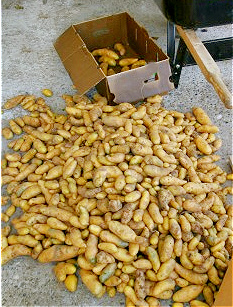Growing heirloom potatoes for home or for market

A version of this article first appeared in AcresUSA Magazine. Photos and text copyright National Lilac Publishing, LLC
by Barbara Berst Adams
The pandemic that began in early 2020 taught the generations removed from the Great Depression about storage crops and home cooking. Potatoes are a versatile staple food that can last months when stored in cool temperatures. And heirloom potatoes, like the ones grown on Salt Creek Farm, can turn their addition to our diets into a gourmet adventure and history lesson.
“Ozette” is a favorite potato grown on 12-acre organic Salt Creek Farm in Port Angeles, Washington, owned by Doug Hendrickson and Lee Norton, twice winners of a Farmer of the Year award. “It is a fingerling potato,” Hendrickson said, “named after a Native American Village on the coast of the Olympic Peninsula. Its yellow tubers are from two to eight inches long with thin yellow skin. Flesh is creamy yellow and flaky when baked. It’s said to have been brought from Peru by Spanish Explorers to the Makah tribe living near Neah Bay, Washington State.”
On my own Island Meadow Farm, we grew heirloom potatoes for family use and as an occasional sideline product for our restaurant customers. The difference between a freshly dug potato, with its skin so tender one has to hold it gingerly to keep from rubbing it off, and the commercial potato with its skin toughened for long-distance shipment and rougher harvesting methods, is almost like a different vegetable. Add rare varieties to that freshness, and the fun really begins. With rare potato varieties, including very early potatoes and those naturally good at long-term storage, one can have a year-round potato supply that out-tastes anything commercial. And the colors, from lavender to butter-yellow, go beyond mere novelty. Potatoes have a variety of qualities that make some excel as roasters, boiled, hashed browns, baked, as salad potatoes, or mashers. Here are a few examples to give a hint at what’s available.
The Heirlooms
The natives of Peru are credited for first cultivating the potato more than 4500 years ago. Spanish explorers brought them home, where they spread across Europe and then throughout the world becoming vast in their diversity of flavors and types after years of careful selection by gardeners and small farmers. But in the 19th century, hybrid vegetables were introduced, and it became the norm to grow large monocrops of a single type of hybrid. If people become dependent on a single variety that succumbs to disease, we have crisis like the Irish potato famine that killed one million people. Yet over in Mexico at that time, blight resistant potatoes were producing well. Had potato diversity been continued rather than the introduction of mono-crops of hybrids, the story may have been different. Many potato varieties may have survived. This is why many sustainable farmers and gardeners are now returning to the heirlooms. They’re not only fun to grow, they are helping keep natural genetic diversity alive. Ronniger’s Potato Farm of Idaho, owned by David Ronniger and family, can be credited for initiating the movement to keep high quality heirloom potatoes alive and available. The farm started as a small seed potato farm selling out of a pickup truck in the 1980s. Today its 106 certified organic acres sells very unique and valuable strains of seed potatoes across the country. (See our profile of Ronniger's Potato Farm here).
Heirloom potatoes come in a rainbow of colors and interesting sizes and shapes. The French fingerling, for example, has yellow flesh and silky smooth pink skin. The tubers are medium to large, allowing for a plate to hold two or three mediums per serving or one large (a choice fine chefs sometimes like to make, being the artists that they are). Fingerlings grow differently than their more familiar cousins. Yields can be large, but they usually don’t bulk up until the very end of the season, and they appear to have more resistance to late blight.
“Ruby Crescent” is another fingerling considered ‘waxier’ than other potatoes and therefore makes a great roasting potato (we tend to like starchy vs. waxy for mashers). Possibly the most finger-shaped of all the fingerlings.
“Purple Peruvian” is a purple fingerling popular at farmers’ markets, and “Russian Banana” is another popular market fingerling potato. It is all yellow, both flesh and skin.
As far as regular-sized potatoes, an early maturing favorite is “Caribe,” with lavender skin and white flesh, producing very large potatoes in early summer (65+ days).
An heirloom that’s even somewhat earlier is “Carlotta,” which is yellow skinned with yellow flesh. A late variety (90+ days) that produces in the cool late season evenings and keeps well is “Blue Victor,” an heirloom with dark blue skin and white flesh. And for an all- purpose potato, “German Butterball” has bright butter-yellow flesh, naturally thicker skin (good for natural storage), and can be prepared in just about every way people like to serve potatoes.
Growing, Harvest and Storage
Whether purple, fingerling or plain old russet, whether growing roasters or bakers or mashers, potatoes are usually divided into three planting categories: Early, midseason, and late. Early quick-maturing types are often harvested as new potatoes and usually ready once the plant is in full flower. They are planted as early as possible and harvested about two months later. Midseason potatoes are planted a few weeks after early varieties, and in most of the country are harvested beginning July. Late varieties are most often the good storage types, and can be planted the same time as mid-season. They are harvested in fall, and in milder climates, are sometimes planted in the fall for spring harvest. Cold frames can also allow potato harvesting in winter and early spring before the next crop of new potatoes arrives.
If you are starting out by purchasing seed outside the farm, begin with certified and organic potato seed if possible, which guarantees the potato carries no virus. There are different opinions on whether those planting from their own potatoes should cut each potato into chunks with one or two ‘eyes’ and therefore get more plants from that single potato, or to just plant the whole potato, with the theory that the particular plant may produce more and better if planted with the whole potato. Whichever method chosen, the potato plants can be given a head start well before spring frosts end by allowing them to sprout ahead of planting time, up to six weeks before planting. It is suggested by some growers to put the potato seed, potato chunks, or whole potatoes themselves in a frost-free location with the eyes exposed to light, but not direct sunlight. This allows for short, stockier sprouts rather than thin straggly ones.
Potatoes thrive in rich garden soil, and can even be placed within compost and mulch to grow. Once planted, potatoes have the oddity of producing more tubers if the plant is kept mostly covered as it sprouts out of the ground. Gardeners continually hoe soil around the plant or throw compost or mulch over it as it pushes upwards. Another innovative way to grow them is by putting each plant inside a circular wire cage where shredded leaves, seaweed, or harvested chopped comfrey are piled up around the plant as it grows, with the litter held in place inside the cage. At harvest time, the cage is opened and potatoes are collected from the clean litter.
If companion planting is desired, an often disliked weed, Amaranth, is very good at siphoning minerals from the subsoil, and makes a great companion to potatoes if kept thinned. Spuds have been found to do well grown with beans, as the beans protect from Colorado potato beetle and the potatoes protect against Mexican bean beetle. They do well after a cover crop of rye, but should not be planted after a previous crop of the nightshade family (such as tomatoes).
Early and new potatoes are usually ready when the plant is in full flower, same with mid-season. Storage potatoes are harvested once the foliage has wilted. For all three, a few can be harvested from the top couple of inches of soil or compost surrounding the plant before the main harvesting of the plant. Then replace the soil or compost around the plant.
For long-term storage, it’s best to harvest storage potatoes if possible on a sunny day, and let them dry in the sun for an hour or two, toughening up the skin. It’s best not to wash them at this time to keep from breaking open the skin. Then, dry them for another week or two in the dark around 60 degrees. After this, a variety of classic long-term storage methods, from root cellars to earth barrels (no light, lots of ventilation, and temperatures around 40 degrees) will keep you in potatoes for two to four months, depending on variety and storage conditions. When freezing potatoes, most people cook them first. But new potatoes can be frozen fresh from the garden if blanched briefly first for six to eight minutes after scrubbing. Drain and place them into labeled freezer bags. When it’s time to serve, simply cover with water and cook until tender.
Marketing Tips
When marketing unusual potatoes, remember that “finding something new” among familiar staples brings the kid out in many customers. Yet “chancing the unfamiliar” can be a challenge for others.
The magic potion for Island Meadow Farm was to give free taste samples at the precise time we were certain they would be used. We took free samples of the prettiest potatoes to busy chefs on Friday afternoons. They could not resist putting the new item on a plate or two and tasting it themselves. This always caused our chefs to ask to purchase more. Another possibility is preparing taste samples of mashed, roasted, baked, or otherwise deliciously prepared potatoes at the farmers’ market, supervised roadside stand, or on pick-up day for a community supported agriculture farm. When cooked samples are not possible, consider adding a couple recipes with the description and history of the unusual crop to community supported agriculture shares, or on a sign at the farmers’ market display, which helps quench the customers’ desires for more knowledge on whether to spend their money on a new item. “We introduce new and exotic varieties to our customers (subscribers) exclusively through our Community Supported Agriculture Project, now 10 years old,” said Doug Hendrickson of Salt Creek Farm.
So whether you plan to simply supply year-round food for the family, get deeper into gourmet and heirloom cooking, or are looking for more items to add to your market garden list, the potato can add color, variety, flavor and history.
___________
Got an unregistered and unlicensed farm pick-up that rarely leaves your property but needs to go on the road legally on rare occasion? Or how about a registered truck you use personally and also for the farm? You may be able to save insurance on it if you qualify. These articles on how other farmers have handled these issues are here: Unregistered farm truck; Farm and personal truck.

Recipe
Grandma Gee’s Cream of Potato Soup
4 cups peeled and diced potatoes
1½ cups water or chicken stock
2 sliced celery stalks
1 sliced medium onion
Combine and simmer 30 minutes.
(Optional: sauté’ onions and celery in butter first)
Puree' in blender for smooth soup, mash with potato masher for a chunkier style.
Stir 2 to 2½ cups milk or light cream into the puree, and heat gently. Salt and pepper to taste.







